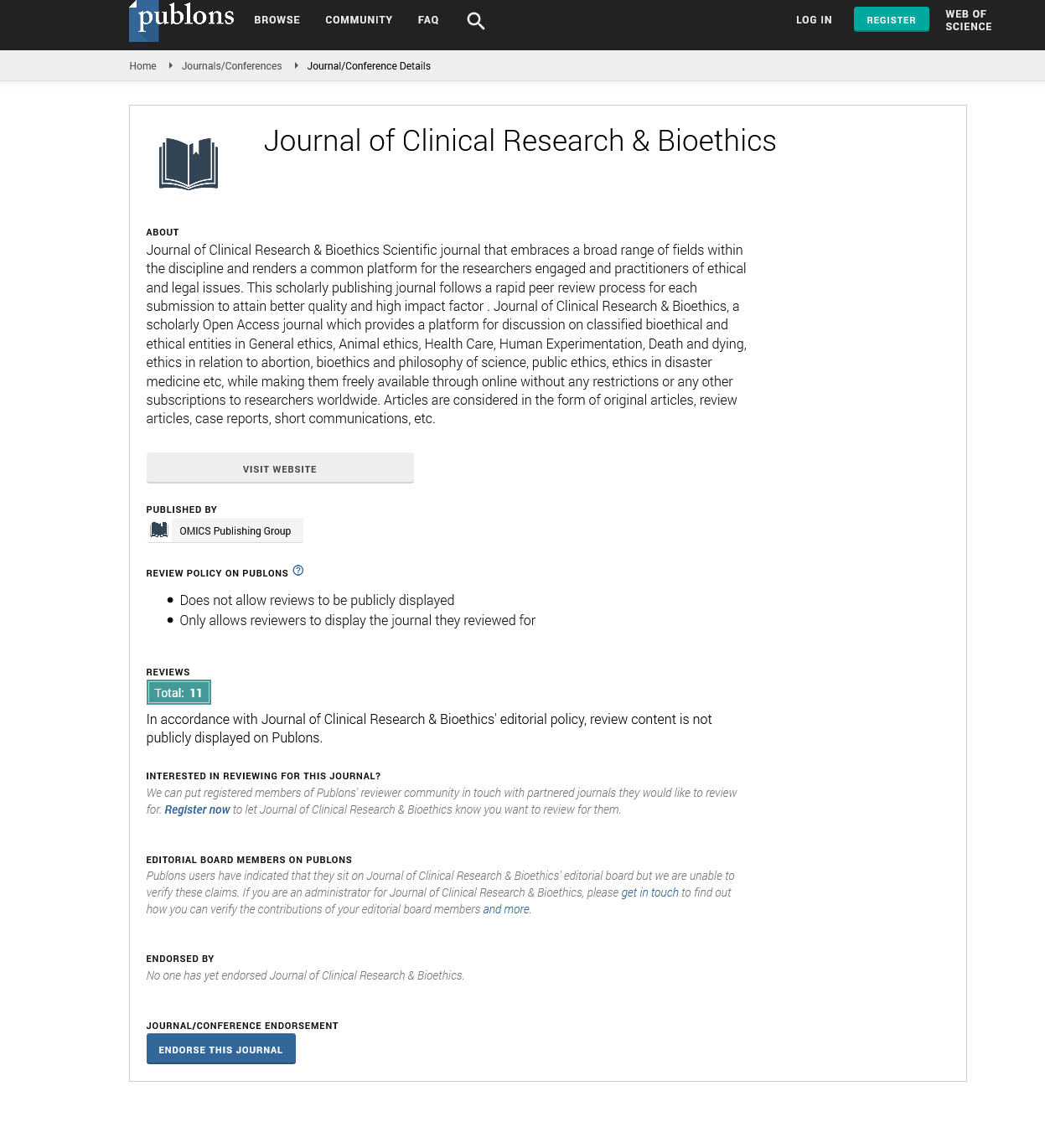Indexed In
- Open J Gate
- Genamics JournalSeek
- JournalTOCs
- RefSeek
- Hamdard University
- EBSCO A-Z
- OCLC- WorldCat
- Publons
- Geneva Foundation for Medical Education and Research
- Google Scholar
Useful Links
Share This Page
Journal Flyer

Open Access Journals
- Agri and Aquaculture
- Biochemistry
- Bioinformatics & Systems Biology
- Business & Management
- Chemistry
- Clinical Sciences
- Engineering
- Food & Nutrition
- General Science
- Genetics & Molecular Biology
- Immunology & Microbiology
- Medical Sciences
- Neuroscience & Psychology
- Nursing & Health Care
- Pharmaceutical Sciences
Short Communication - (2025) Volume 16, Issue 7
Balancing Scientific Innovation and Ethical Responsibility in Clinical Research
Yasmin Khalid*Received: 01-Jul-2025, Manuscript No. JCRB-25-29549; Editor assigned: 03-Jul-2025, Pre QC No. JCRB-25-29549 (PQ); Reviewed: 17-Jul-2025, QC No. JCRB-25-29549; Revised: 24-Jul-2025, Manuscript No. JCRB-25-29549 (R); Published: 31-Jul-2025, DOI: 10.35248/2155-9627.25.16.539
Description
The advancement of clinical research has been instrumental in shaping modern medicine, offering new therapies, diagnostic tools, preventive strategies that have saved countless lives. However, the pursuit of innovation often collides with profound ethical dilemmas, raising the question of how far science should go in experimenting with human health. Balancing the dual goals of scientific progress and ethical responsibility has become a defining challenge in clinical research and bioethics, requiring constant vigilance to protect human dignity without stifling discovery [1]. Historically, the tension between innovation and ethics has been highlighted by notorious cases of misconduct that have left indelible marks on research ethics. From the Tuskegee syphilis study to unethical trials conducted without consent in vulnerable populations, history demonstrates that when ethical safeguards are compromised, both participants and science itself suffer irreversible harm. These cases prompted the development of international ethical frameworks, such as the Nuremberg Code, the Belmont Report, the Declaration of Helsinki, which collectively emphasize the principles of respect for persons, beneficence, justice [2].
Scientific breakthroughs often require a degree of risk as medical progress is rarely achieved without uncertainty. Clinical trials, by design, involve testing interventions that have not yet been proven safe or effective in humans. This reality creates a moral obligation to minimize risks while maximizing potential benefits, a task that is often more complicated than it appears. Determining acceptable levels of risk is highly context-dependent, influenced by the severity of the condition being studied, the availability of alternative treatments, the vulnerability of participants. In high-stakes research, such as trials for life-threatening diseases, patients may be willing to accept greater risks, but researchers must remain cautious to ensure that desperation does not override ethical boundaries [3].
One of the most pressing ethical issues in modern clinical research is the unequal distribution of benefits and burdens. Many trials are conducted in low- and middle-income countries where participants may lack access to basic healthcare. While these studies can bring resources and potential therapies to underserved populations, they also raise concerns about exploitation. Ethical responsibility demands that research conducted in such settings not only respects participants but also ensures that host communities benefit from the knowledge and interventions generated. Without this reciprocity, research risks becoming a form of medical colonialism where vulnerable populations are used as means to an end [4].
The integration of emerging technologies into clinical research further complicates the ethical landscape. Genomic medicine, artificial intelligence, digital health platforms offer unprecedented opportunities for personalized care and predictive analytics. Yet they also bring new risks related to privacy, data security, informed consent. For instance, genomic research often involves the collection of sensitive information that extends beyond the individual to their relatives, raising questions about consent and confidentiality across generations. Similarly, the use of big data in clinical research challenges traditional models of consent, as participants may not fully grasp how their information will be used or shared in the future. Ethical responsibility in such contexts requires not only transparency but also proactive efforts to safeguard data and empower participants with meaningful control over their information [5].
Another aspect of balancing innovation with ethics lies in the role of regulatory oversight. Institutional Review Boards (IRBs) and ethics committees act as guardians of participant welfare, reviewing study protocols to ensure that risks are minimized and ethical standards upheld. However, there is often criticism that excessive regulation slows the pace of research, deterring innovation and delaying access to potentially life-saving treatments. The challenge lies in finding a middle ground where oversight protects participants without creating unnecessary bureaucratic barriers. Innovative models, such as adaptive trial designs and expedited ethical reviews for urgent research, represent attempts to harmonize efficiency with responsibility [6].
Patient engagement has also emerged as a critical component of ethical research. Involving participants not just as subjects but as active partners in the research process enhances both ethical responsibility and scientific validity. Patients can provide valuable insights into what outcomes matter most to them, how risks are perceived, what trade-offs they are willing to accept. Such collaboration shifts research from being something done to participants to something conducted with them, fostering mutual respect and trust. Ethical responsibility, therefore, is not solely about protecting participants but also about empowering them as stakeholders in the scientific process [7].
An additional consideration is the dissemination of research findings. Ethical responsibility does not end with the completion of a trial; it extends to ensuring that results, whether positive or negative, are communicated honestly and transparently. Selective reporting or withholding unfavorable data undermines scientific integrity and can cause real harm by distorting medical decision-making [8]. Researchers and sponsors have a duty to publish findings in accessible formats, contributing to the collective body of knowledge that informs clinical practice. This principle also aligns with the growing movement toward open science, which emphasizes data sharing and collaboration across borders to accelerate discovery while maintaining accountability [9].
Ultimately, the balance between scientific innovation and ethical responsibility requires a mindset that views the two not as opposing forces but as complementary pillars of meaningful research. Innovation without ethics risks exploitation and loss of public trust, while ethics without innovation risks stagnation and the failure to address pressing health challenges. The path forward lies in integrating ethical reflection into every stage of the research process, from study design to implementation and dissemination. Researchers, ethicists, policymakers, communities must work together to create a culture of responsibility that nurtures both scientific progress and human dignity [10].
Conclusion
clinical research thrives when scientific ambition is guided by ethical responsibility. Striking this balance is neither simple nor static; it requires constant adaptation to new technologies, evolving social contexts, shifting patient needs. However, by prioritizing respect for persons, fairness, transparency, the research community can ensure that innovation continues to advance without compromising its ethical foundation. The future of clinical research depends not only on what is discovered but also on how those discoveries are pursued and shared with humanity.
References
- Aboul-Fotouh S, Mahmoud AN, Elnahas EM, Habib MZ, Abdelraouf SM. What are the current anti-COVID-19 drugs? From traditional to smart molecular mechanisms. Virol J. 2023; 20(1):241.
[Crossref] [Google Scholar] [PubMed]
- Andrews HS, Herman JD, Gandhi RT. Treatments for COVID-19. Annu Rev Med. 2024; 75:145-157.
[Crossref] [Google Scholar] [PubMed]
- Yang X. Passive antibody therapy in emerging infectious diseases. Front Med. 2023;1-8.
[Crossref] [Google Scholar] [PubMed]
- Schrezenmeier H, Hoffmann S, Hofmann H, Appl T, Jahrsdorfer B, Seifried E, et al. Immune Plasma for the Treatment of COVID-19: Lessons Learned so far. Hamostaseologie. 2023; 43(1):67-74.
[Crossref] [Google Scholar] [PubMed]
- Stadler E, Chai KL, Schlub TE, Cromer D, Polizzotto MN, Kent SJ, et al. Determinants of passive antibody efficacy in SARS-CoV-2 infection: A systematic review and meta-analysis. Lancet Microbe. 2023; e883-e892.
[Crossref] [Google Scholar] [PubMed]
- Filippatos C, Ntanasis-Stathopoulos I, Sekeri K, Ntanasis-Stathopoulos A, Gavriatopoulou M, Psaltopoulou T, et al. Convalescent plasma therapy for COVID-19: A systematic review and meta-analysis on randomized controlled trials. Viruses. 2023;15(3):765.
[Crossref] [Google Scholar] [PubMed]
- Levine AC, Fukuta Y, Huaman MA, Ou J, Meisenberg BR, Patel B, et al. Coronavirus disease 2019 convalescent plasma outpatient therapy to prevent outpatient hospitalization: A meta-analysis of individual participant data from 5 randomized trials. Clin Infect Dis. 2023;76(12):2077-2086.
[Crossref] [Google Scholar] [PubMed]
- Senefeld JW, Gorman EK, Johnson PW, Moir ME, Klassen SA, Carter RE, et al. Rates among hospitalized patients with COVID-19 treated with convalescent plasma: A systematic review and meta-analysis. Mayo Clin Proc Innov Qual Outcomes. 2023; 7(5):499-513.
- Kumar NR, Karanam VC, Kumar S, Kumar SD. Convalescent plasma therapy in late-state, severe COVID-19 infection. South Med J. 2023;116(5):427.
[Crossref] [Google Scholar] [PubMed]
- Mihalek N, Radovanovic D, Barak O, Colovic P, Huber M, Erdoes G. Convalescent plasma and all-cause mortality of COVID-19 patients: Systematic review and meta-analysis. Sci Rep. 2023;13(1):12904.
[Crossref] [Google Scholar] [PubMed]
Citation: Khalid Y (2025). Balancing Scientific Innovation and Ethical Responsibility in Clinical Research. J Clin Res Bioeth. 16:539.
Copyright: © 2025 Khalid Y. This is an open-access article distributed under the terms of the Creative Commons Attribution License, which permits unrestricted use, distribution and reproduction in any medium, provided the original author and source are credited.

